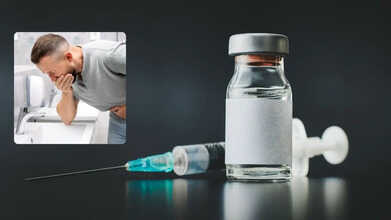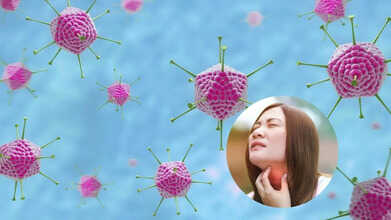- Health Conditions A-Z
- Health & Wellness
- Nutrition
- Fitness
- Health News
- Ayurveda
- Videos
- Medicine A-Z
- Parenting
Why Is Gen Z Drinking Less?

Gen Z drinking (Credit: Canva)
As dry January begins, everyone is trying to cut off alcohol. While there resolve may or may not last until the end of the year, there is one generation that has already started cutting back on Alcohol: Gen Z. This is a cohort which was born between late 1900s and 2010s and there is data to support this.
Statistics from the National Institute on Drug Abuse indicates that lifetime drinking, past month drinking and past year drinking among young people began to decline around the year 2000. The consumption of alcohol among Gen Z is on the decline, and experts attribute this shift to a combination of evolving laws, changing social norms, and health-conscious attitudes.
Switch to a healthier lifestyle?
Health experts point out that younger generations are much more interested in living healthy lifestyles than generations past. Evolving alcohol marketing tactics reflect those changing values. In past, the focus of these adverts was on "partying harder", while now it is they are just stopping short of saying that it is healthy to have some drinks and it is possible to have alcohol in your healthy lifestyle.In US alone, there has been a steady growth in sober bars.
Another prime factor behind this change is the alteration in drinking alws across the world. Most of the countries, updated the minimum age for drinking from 18 to 21 years. This legislative change has contributed to reduced access to alcohol for younger individuals, potentially shaping generational drinking patterns.
The social perception of alcohol has also transformed over time. Baby Boomers (generation of people born between 1946 and 1964)
were immersed in a culture where drinking was more prevalent,” says Dr. George Koob, director of the National Institute on Alcohol Abuse and Alcoholism. Similarly, Dr. Sybil Marsh, a family medicine physician specializing in addiction, notes that alcohol was once seen as a marker of sophistication. Today, younger generations view relaxation and self-expression through broader lenses, diminishing alcohol's symbolic significance.
**The Marijuana Factor**
Cannabis legalization in nearly half of U.S. states has introduced an alternative to alcohol. Dispensaries are now accessible to nearly 80% of Americans, with cannabis beverages targeting younger consumers. According to the 2023 National Survey on Drug Use and Health, 36.5% of adults aged 18–25 reported using marijuana in the past year. However, alcohol use still surpasses cannabis, with 68.1% of individuals in the same age group consuming alcohol.
**Changing Social Habits**
Alcohol’s traditional role as a social lubricant may also be waning due to shifting social behaviors. “Alcohol is often a social drug, but with younger generations socializing less in person, underage drinking has declined,” explains Koob. Data from the U.S. Surgeon General’s advisory on loneliness reveals a drop in in-person socializing among 15–24-year-olds, from 30 hours monthly in 2003 to just 10 hours by 2020.
**The Rise of Health-Conscious Lifestyles**
Younger generations are prioritizing wellness, reshaping alcohol marketing strategies. “Today’s advertising focuses on integrating alcohol into a balanced lifestyle, moving away from the Gen X ‘party hard’ narrative,” says Marsh. Reflecting this trend, sober bars like Hekate in New York City, Sans Bar in Austin, and The Sober Social in Atlanta have emerged to meet the growing demand for alcohol-free social spaces.
For many Gen Z individuals, personal health and family histories influence drinking habits. Emerson Haven, a 26-year-old stage director, shares his cautious approach: “There’s a history of alcoholism in my family, so I’m mindful about drinking. I avoid alcohol on bad days to prevent negative associations and often prefer sober nights for health reasons.”
As the cultural and social landscape continues to evolve, Gen Z is redefining the role of alcohol in their lives, emphasizing mindfulness, health, and alternative ways to unwind.
Adenovirus: Highly Contagious Mystery Illness Spreading Fast, Watch Out for These 12 Symptoms

Credits: Canva
The so-called “mystery virus” behind lingering sore throats, blocked noses filled with mucus, and days of exhaustion is actually well known to doctors. According to Eric Sachinwalla, medical director of infection prevention and control at Jefferson Health, the culprit is adenovirus.
What makes this virus particularly difficult to control is how tough it is. Adenovirus can survive soap and water, withstand many everyday disinfectants, and linger on contaminated surfaces for long stretches of time. Below is what experts know so far about this fast-spreading infection.
What Is Adenovirus?
Adenovirus refers to a group of common viruses that usually trigger cold- or flu-like illness. It spreads easily because it is far more resilient than many other viruses. Ordinary soap, water, and standard disinfectants do not reliably destroy it, allowing it to persist in the environment. As a result, infections often cluster in places where people spend time close together, such as daycares and military barracks. The virus spreads through the respiratory tract, can be shed in stool, and can survive for some time on contaminated surfaces, according to the CDC.
Adenovirus: What Are The Symptoms Of Adenovirus?
“Adenovirus is a typical virus that causes common cold or flu-like symptoms,” says Dr Deborah Lee at Dr Fox Online Pharmacy. That does not mean adenovirus is the same as a cold. Instead, adenovirus is one of many germs that can cause cold-like illness. A simple way to think about it is that a “cold” describes the symptoms, while adenovirus is one specific virus that can lead to them.
Symptoms can vary depending on the subtype involved. While there are more than 100 known subtypes, only 49 infect humans. Dr Lee notes that people may experience any of the following:
- Fever
- Runny nose
- Sore throat
- Swollen cervical lymph nodes in the neck
- Cough
- Shortness of breath
- Conjunctivitis
- Ear pain
- Diarrhoea
- Vomiting
- Stomach pain
- Urinary tract infection
Adenovirus? Is It Contagious?
“Adenovirus infection is highly contagious,” Dr Lee explains. “It spreads by breathing in infected droplets, by touching the virus and then rubbing the eyes, or through the faecal-oral route, often due to poor hand hygiene after using the toilet.”
She adds that the virus spreads quickly in crowded settings where people are in close contact. To eliminate adenovirus from surfaces, Dr Lee recommends stronger cleaning agents such as bleach-based solutions or hydrogen peroxide. “The virus is resistant to soap and many commonly used cleaners,” she says.
To reduce the risk of catching adenovirus or other respiratory infections currently circulating, Dr Lee advises staying away from people who are unwell. She also suggests the following precautions:
- Avoid touching your face and nose
- Use a clean tissue to blow your nose and dispose of it immediately
- Wash your hands often with soap and warm water, then dry them thoroughly, especially after using the toilet or changing nappies
- Clean children’s toys regularly
- Disinfect worktops, changing areas, toilets, and bathrooms
- Avoid sharing cups, plates, food, or towels
- Wear a mask if you need to go out while unwell
- Keep windows open and ensure rooms and workspaces are well ventilated.
Norovirus 2025: Is There A Vaccine For The Stomach Bug Spreading This Year?

Credits: Canva
Dozens of norovirus outbreaks have been recorded nationwide over the past few weeks, and as people deal with intense vomiting, diarrhea, and other uncomfortable or even risky symptoms, a common question keeps coming up: why is there still no vaccine for such a widespread infection.
The Centers for Disease Control and Prevention (CDC) says norovirus cases are increasing toward the end of 2025, with higher activity reported in both the US and the UK. Health officials note that a new, highly infectious strain known as GII.17 is partly driving this rise. Because many people have little or no immunity to it, outbreaks are being seen more often in schools and shared public spaces. While overall case numbers remain within typical seasonal ranges, recent weeks have shown a clear upward trend.
What Is Norovirus?
Norovirus is an extremely contagious virus that leads to gastroenteritis. It commonly causes symptoms such as vomiting, diarrhea, nausea, and stomach cramps, and may also bring fever and body aches. It is often referred to as the ‘stomach flu,’ though it has no connection to influenza.
The virus spreads quickly through contaminated food or water, shared surfaces, or direct contact with an infected person’s vomit or stool. Crowded settings like cruise ships are especially vulnerable. Most people recover within one to three days with rest and enough fluids, according to the CDC.
Norovirus Symptoms 2025
Norovirus usually comes on suddenly, causing vomiting, watery diarrhea, nausea, and abdominal pain. Fever, headaches, and body aches are also common. Symptoms typically appear 12 to 48 hours after exposure and last for one to three days. Because it spreads so easily, infections can move fast through families and communities.
While most cases improve on their own, dehydration is a concern, so warning signs such as intense thirst or reduced urination should not be ignored, as noted by the Cleveland Clinic.
Do We Have A Norovirus Vaccine?
At present, there is no widely available vaccine for norovirus. That said, research has made meaningful strides. Experimental oral vaccines have shown encouraging results in clinical studies, suggesting they may offer protection against multiple fast-changing strains and help reduce how much virus an infected person sheds. Scientists are hopeful that an effective, broadly protective vaccine may become available in the coming years, according to the National Institutes of Health.
Why Don’t We Have a Norovirus Vaccine Yet?
Developing a vaccine for norovirus has proven especially difficult, largely because of how quickly the virus changes. “It really is evolving extremely rapidly, and that’s a big problem,” Patricia Foster, PhD, professor emerita of biology at Indiana University Bloomington, told Health.
Norovirus also exists in dozens of subtypes, with several dominant strains circulating at any given time. This is why people can catch norovirus more than once in their lives. Even if immunity develops against one strain, either after infection or through vaccination, another strain can still cause illness. Centers for Disease Control and Prevention. About norovirus.
Norovirus: Multiple Vaccines Are In The Works
Despite these obstacles, vaccine research is moving forward. Progress has accelerated in part because of newer technologies developed over the past decade. In 2016, Mary Estes, PhD, a researcher at Baylor College of Medicine, and her team found a way to grow norovirus outside the human body. This breakthrough made it possible to test vaccine approaches and treatments more effectively. This step was crucial because common lab animals like mice do not typically get sick from human norovirus.
Today, scientists are testing several experimental vaccines. One example is a 2023 vaccine developed at Washington University School of Medicine in St. Louis that combines protection against norovirus with an existing rotavirus vaccine. Several pharmaceutical companies are also developing candidates, many of which are now in clinical trials, said Amesh Adalja, MD, senior scholar at the Johns Hopkins Center for Health Security, in comments to *Health*.
HilleVax, a Boston-based company, has been testing a norovirus vaccine originally developed by Japan’s Takeda. However, that candidate did not succeed in a phase II trial in June 2024. Meanwhile, a tablet-style norovirus vaccine from San Francisco-based Vaxart has completed phase I testing. Among the most promising efforts is Moderna’s vaccine, which is currently being tested in human volunteers.
Preventing Norovirus, Even Without a Vaccine
Norovirus spreads so easily that stopping it once someone falls ill can be very challenging. This is linked to the virus’s structure. Norovirus is a nonenveloped virus, similar to polio and other stomach-related infections. Because of this, neither hand sanitizers nor soap and water actually destroy the virus, Foster explained. “Handwashing helps because you’re physically rinsing the virus away,” she said.
As a result, basic hygiene practices, especially thorough handwashing, remain some of the most effective ways to lower risk, said Ming Tan, PhD, an infectious disease researcher and associate professor of pediatrics at Cincinnati Children’s Hospital Medical Center, speaking to *Health*.
If norovirus does strike, treatment options are limited. Staying hydrated is essential to avoid complications from fluid loss. Some people may also use medicines to control nausea or diarrhea, either over the counter or by prescription, such as Zofran. If severe symptoms develop, including confusion, high fever, or intense abdominal pain, medical care should be sought right away.
Mystery Disease Adenovirus: New Virus Said To Be Stronger Than Covid And Flu — All You Need To Know

Credits: Canva
Adenovirus: A newly emerging “untreatable” mystery virus that is being described as stronger than Covid is now spreading across several parts of the world, with experts warning that even common disinfectants may not be effective against it. Known as adenovirus, the infection causes symptoms similar to a severe bout of flu, such as shortness of breath, a runny nose, and a sore throat. What sets it apart, however, is the limited treatment available.
In most cases, people who contract the virus have no option but to manage symptoms and allow the illness to pass on its own. The good news is that adenovirus infections are usually mild. That said, much like Covid or seasonal flu, the risk rises for people with weakened immune systems, who may experience more serious complications, according to a report by The Mirror.
Jefferson Health’s medical director of infection prevention and control, Eric Sachinwalla, has cautioned that unlike more familiar viral infections, there is very little doctors can do to actively treat adenovirus.
What Is Adenovirus?
Adenoviruses belong to a broad family of common viruses that can affect multiple parts of the body, including the airways and lungs, eyes, digestive system, urinary tract, and even the nervous system. They are a frequent cause of fever, cough, sore throat, diarrhoea, and conjunctivitis. Most infections tend to be mild and clear up on their own within a few days. However, health experts are now noting a rapid rise in cases, with the virus spreading quickly and leaving large numbers of people unwell.
The virus is particularly contagious because it is tougher than many others. Routine cleaning with soap and water or standard disinfectants may not be enough to eliminate it, allowing it to survive longer in the environment. This is why outbreaks are often seen in places such as day-care centres and military barracks, where close contact is common. Adenovirus spreads through respiratory droplets, can be passed through stool, and can linger on contaminated surfaces for extended periods, as per Mirror.
Adenovirus Symptoms
Symptoms of adenovirus infection can vary widely. Common signs include shortness of breath, a runny nose, and a sore throat. Some people may also develop diarrhoea or pink eye. The wide range of symptoms is partly due to the fact that there are more than 60 known strains of the virus.
Adenovirus: How Is Adenovirus Different From Covid And Flu?
Adenoviruses, like coronaviruses, spread from person to person and can trigger similar respiratory symptoms. However, they belong to entirely different virus families and behave differently. One key difference is resistance. Coronaviruses are more easily destroyed by disinfectants, while adenoviruses are harder to kill, which allows them to spread more easily than Covid or flu.
For otherwise healthy individuals who feel unwell but do not have severe symptoms such as high fever or breathing difficulty, recovery usually happens at home with basic supportive care. Medical attention is more important for people with weakened immunity, parents of very young infants, or those with existing conditions like heart or lung disease. If symptoms appear, experts advise against walking straight into a clinic. Calling ahead is safer, as doctors may recommend a telehealth consultation if the illness seems highly contagious.
Adenovirus: Is Adenovirus Untreatable?
Most adenovirus infections are mild and resolve without medical treatment. However, if symptoms linger or worsen, there is often little doctors can do beyond monitoring and symptom relief, as the virus largely needs to run its course. Following basic hygiene measures, such as washing hands regularly and cleaning frequently touched surfaces, remains one of the most effective ways to reduce the risk of infection.
© 2024 Bennett, Coleman & Company Limited

